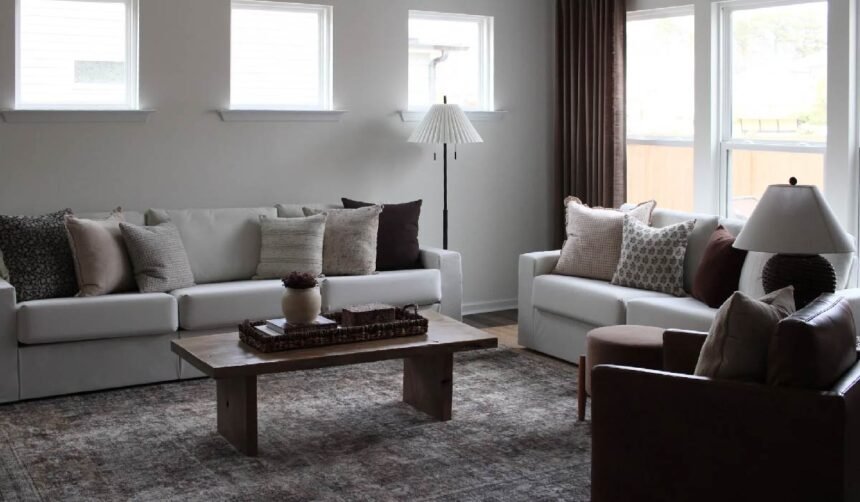Becoming a new parent often means reimagining your living space. As the heart of the home, the living room must balance style, safety and everyday practicality to support the whole family.
With a few intentional choices, you can create a calm, organised space that adapts as your child grows.
Creating a cosy and functional living room doesn’t mean sacrificing style; it’s about making intentional choices that support your family’s changing needs while maintaining a peaceful, organised space where everyone can thrive.
Prioritising Comfort and Safety for Families
Creating safe and comfortable living spaces takes on new meaning when little ones enter the picture.
A well-designed living room needs to strike the perfect balance between cosiness and safety features. Smart furniture choices, like a versatile modular family sectional couch that adapts to your family’s changing needs, can make a huge difference in daily life.
Parents should incorporate rounded edges and child‑friendly materials throughout the room. Easy‑clean fabrics aren’t just practical; they’re essential for keeping the space fresh and welcoming. Choose sturdy, tip‑resistant furniture and low‑VOC finishes for healthier indoor air.
While creating these safe havens, it’s worth noting that 68 per cent of families received assistance in 1996, showing how support systems have shifted over time.
Key elements to consider when setting up a family-friendly living room:
- Soft, washable upholstery that stands up to spills and messes
- Furniture with rounded corners to prevent injuries
- Open layouts that allow clear sight lines to monitor children
- Sturdy, stable pieces that won’t tip over easily
- Non-toxic materials and finishes throughout the space
Remember that flexibility is your friend when planning your space. As your children grow, your room should adapt while maintaining its core safety features.
Choosing multipurpose pieces and arranging furniture to create clear pathways helps create a space that’s both protective and practical for daily family life.
Organising for Practicality and Everyday Function
Smart storage options transform a living room from chaotic to calm, making daily life with little ones much smoother. Efficient organisation isn’t just about tidiness; it’s about creating a space where both parents and children can thrive.
A well-planned living area helps maintain order while encouraging children to participate in keeping their space neat.
Here are key storage solutions that blend function with style in your family’s living room:
- Closed storage bins for hiding away toys and supplies
- Open baskets that make grabbing everyday items quick
- Built-in shelving for books and display items
- Multi-purpose furniture with hidden storage
- Clear containers to help children identify contents
Creating dedicated spots for different activities helps establish routines and teaches children about organisation naturally. Millions of children benefit from organised home environments that support their development while keeping family spaces functional.
The right mix of open and closed storage lets you maintain a clutter-free atmosphere without sacrificing quick access to frequently used items. This balance of practicality and aesthetics helps families create a living space that works for everyone, regardless of budget constraints.
Cultivating a Calm and Welcoming Atmosphere
A thoughtfully designed living room can transform daily family life by creating a peaceful sanctuary for parents and children alike.
Soft, neutral colours like warm beiges, gentle greys, and muted earth tones help reduce visual noise and create a tranquil backdrop for family activities.
Adding plush textures through cushions, rugs, and cosy blankets invites touch exploration while maintaining a clean, uncluttered look.
Steps to create a calming space:
- Layer different textures with smooth cotton, chunky knits, and velvet accents
- Choose washable fabrics in neutral shades that hide minor spills
- Add natural elements like wooden toys and woven baskets
- Install dimmable lighting to adjust the mood throughout the day
- Include soft and floor cushions for flexible seating
The key is finding the right balance between minimalism and comfort. A clutter-free environment helps reduce stress and anxiety, while soft furnishings create welcoming spots for cuddles, playtime, and quiet moments.
Simple organisational systems, like decorative bins and baskets, keep essentials within reach without disrupting the room’s peaceful atmosphere. This approach creates a living space where both parents and children can relax, connect, and thrive together.
Supporting Children’s Independence Through Layout and Design
Thoughtful room layout plays a vital role in nurturing a child’s natural drive for independence. Creating dedicated spaces within your living room can make a significant difference in how children interact with their environment.
A well-planned space encourages children to explore, learn, and play while maintaining the room’s overall function for the whole family.
Setting up distinct activity zones helps children understand spatial boundaries and develop their sense of order. Consider these key elements for creating child-friendly spaces that promote independence:
- Low-level shelving units that let children choose and return toys independently
- Clear containers that display materials and make cleanup easier
- Cosy reading nooks with accessible book storage
- Open floor areas for movement and creative play
- Child-sized furniture that supports proper posture and comfort
Smart furniture placement makes a huge impact on how children use the space. A sectional sofa can define play areas while providing comfortable seating for the family.
The key is maintaining a balance between adult and child spaces. This approach creates a living room that respects children’s need for independence while keeping the space functional for everyone.
Including dedicated zones for different activities helps children develop responsibility and self-confidence as they learn to manage their own activities.
Adapting Living Spaces as Children Grow
Creating flexible spaces in your living room helps you adapt to your family’s changing needs without constant renovations. A thoughtfully planned layout with versatile furniture pieces can transform from a cosy spot for infant care to an engaging area for toddler playtime.
The sectional sofa offers the perfect blend of comfort and adaptability, with plenty of room for family bonding and playtime activities.
Smart furniture choices can make your living room more adaptable. Here’s how to create a space that grows with your children:
- Select modular furniture pieces that can be rearranged easily
- Install adjustable storage solutions at different heights
- Choose sturdy materials that withstand wear and tear
- Add movable play mats and soft furnishings
- Include multi-functional ottoman storage pieces
Planning for the long term becomes even more crucial. A well-designed space can serve multiple purposes without requiring expensive updates.
Focus on creating distinct zones that can shift between tummy time, creative play, and homework areas as your little ones grow. This approach helps maintain organisation while supporting your children’s developing independence and changing interests.
Making Room for What Matters
Creating a safe, functional living room isn’t only about the furniture; it’s about designing a space that supports wellbeing, independence and connection.
By choosing rounded edges, washable fabrics and smart storage, you’ll build a room that evolves with your family, cosy, practical and ready for everyday life.
Your living room can be both a safe haven and a stylish space where precious family memories are made, proving that functionality and beauty can coexist perfectly in a family home.














